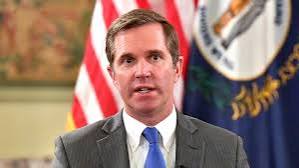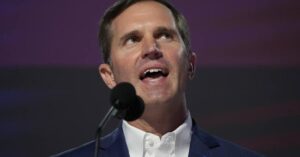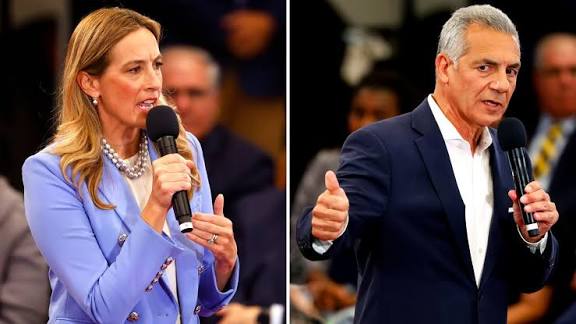Andy Beshear 2028 presidential run: Beshear most popular Democratic governor

Steve Inscape of NPR has talked about his cross-party appeal in a state with Kentki Governor Andy Aashiar which is always heavy. Today we will discuss about Andy Beshear 2028 presidential run: Beshear most popular Democratic governor
Andy Beshear 2028 presidential run: Beshear most popular Democratic governor
As the 2028 U.S. presidential campaign slowly begins to take shape, few names from the Democratic side command as much quiet buzz as Kentucky Governor Andy Beshear. He is often cited as the most popular Democratic governor in the country, a distinction that gives him both national appeal and scrutiny as potential voters and party elites assess whether he could be a serious contender.
This article explores the strengths and challenges Beshear faces in mounting a 2028 bid, how his popularity has been built, and whether that popularity can translate into national viability.
Beshear’s political rise: from Kentucky to national spotlight

Early life, background, and political ascent
Andrew Graham Beshear (born 1977) comes from a political family: his father, Steve Beshear, served two terms as governor of Kentucky (2007–2015).
Before entering elective politics, Andy Beshear worked as an attorney and held the office of Kentucky Attorney General (2016–2019) before launching his 2019 gubernatorial run.
In 2019, Beshear narrowly defeated incumbent Republican Matt Bevin — one of the closest statewide races in Kentucky history — by a margin of around 0.37 percentage points.
That victory, in a state that strongly leans Republican in federal elections, gave Beshear instant attention as a Democratic figure able to succeed in non-blue territory.
Beshear was re-elected in 2023, defeating Republican Daniel Cameron with 52.5 % of the vote to Cameron’s 47.5 %. His re-election solidified his image as a Democratic governor who can hold and expand political capital even in deeply red states.
Building reputation and popularity
A key to understanding Beshear’s appeal is his consistent high approval ratings. Over multiple surveys conducted by Morning Consult, Beshear’s approval has remained significantly above 50%, often placing him among the top governors nationally.
At one point, a Morning Consult poll placed Beshear at 67 % approval, with 28 % disapproval — making him the most popular Democratic governor and second among all governors nationally (behind Vermont Republican Phil Scott).
In other cycles, his approval has held around 65 % or higher.
His popularity is not just among Democrats — Beshear enjoys favorability from independents and even a modest share of Republican voters, an important signal for cross-partisan appeal.
Part of his appeal comes from a messaging style that emphasizes pragmatism, bipartisanship, and moderation — a tone that allows him to navigate Kentucky’s conservative environment while maintaining core Democratic principles.
In national media commentary, he is frequently held up as a model for “blue states learning to talk Southern or Mid-America” or for how Democrats might compete in red states again.
Additionally, Beshear has gained exposure outside Kentucky through strategic appearances — for instance, he traveled to South Carolina in 2025, speaking to local Democrats on how to win in Southern states, and has met with donors at national events.
He also participated in the World Economic Forum in Davos, meeting corporate leaders to promote Kentucky’s economic strengths — an example of raising his national profile through governance credentials.
The case for a Beshear 2028 presidential bid
Given the foregoing, what makes Beshear a serious name to watch for 2028, and what might be his path (and hurdles)?
Red-state credibility & bridging divides
One of Beshear’s strongest assets is his ability to govern and win in a Republican-leaning state. That affords him the narrative of being a bridge-builder: someone who can appeal not only to Democratic base voters but also to moderates and disaffected Republicans. For a party seeking to expand into swing and rural territories, that credibility is valuable.
He also presents a “southern Democrat” profile, offering regional balance in a field that may lean toward coastal candidates. As op-eds have noted, the Democratic Party has sometimes struggled to speak effectively to symbolically “Middle America,” and Beshear could represent that messaging bridge.
High approval & favorable metrics
Beshear’s polling delivers instant legitimacy. Being ranked as the most popular Democratic governor gives him both media narrative and fundraising leverage. Donors often follow perceived electability, and high state approval can help open doors in early states. Already, some Democrats at donor events believe Beshear is running, and his remarks in those forums suggest he is positioning himself accordingly.
Policy portfolio & governing record
Beshear can point to concrete achievements in Kentucky: expanding healthcare access in rural areas, breaking economic development records, and delivering jobs. He frames such governance as the foundation of his broader political ambitions.
His approach suggests a mix of progressive social stances and pragmatic economic policies — an alignment that could appeal to the Democratic center and avoid alienating moderates.
He also has shown a willingness to veto conservative legislation: for instance, in South Carolina campaign stops, he referenced vetoing anti-LGBTQ bills in Kentucky as consistent with his faith and values.
Timing & party opening
The post-2024 landscape gives the Democratic Party a chance to reset. With Joe Biden unlikely to run again, and with party infighting still raw from 2024 losses, there is room for a fresh, consensus figure to emerge. Beshear has cautiously signaled openness to running — he has said he would “consider” the run if he felt he could heal the country.
Additionally, Beshear is slated to serve as head of the Democratic Governors Association in 2026, positioning him to build national networks and visibility before the formal campaign begins.
Challenges and headwinds
No matter how strong someone looks at the state level, a national campaign presents distinct obstacles. Beshear will need to navigate several significant challenges:
Name recognition and national brand
Outside Kentucky and political circles, Beshear remains relatively unknown compared to heavyweights like Gavin Newsom, Gretchen Whitmer, or more nationally visible figures. Overcoming that low baseline will require sustained investments in media, messaging, and national organization.
Translating state popularity to national viability
Being the most popular Democratic governor is an impressive credential, but it doesn’t guarantee national appeal. Voters in primaries weigh many factors: ideological fit, charisma, fundraising capacity, coalition building, and more. Some commentators caution that success in a red state may not automatically translate to broad appeal on contentious national issues.
Additionally, polling for 2028 currently places Beshear rather low — in the 1–3 % range in early look-ahead averages, trailing major names such as Kamala Harris or Pete Buttigieg. He will need to improve that significantly.
Intra-party competition & ideological tensions
The Democratic Party’s 2028 primary field is likely to be crowded with more established figures. Beshear must differentiate himself and carve a niche. He must balance messaging to satisfy progressive wings (especially on climate, racial justice, inequality) while maintaining moderate appeal. Missteps could alienate parts of his base.
Moreover, in an era of deep polarization, some Democratic voters may view his moderation skeptically, questioning whether he would push strong progressive policies or compromise too heavily. He may face criticism from the left for being too centrist.
Fundraising, infrastructure, and organization
To run a competitive national campaign, Beshear will need a strong fundraising network, staff infrastructure in early states, media operations, and grassroots mobilization. Kentucky’s success doesn’t directly supply that — he must build it from scratch. He must also manage competing demands on his current role as governor (he is committed to finishing his Kentucky term through 2027).
Political dynamics & partisan headwinds
Even if Beshear runs a strong campaign, he would confront structural headwinds. Republicans will attack him as insufficiently firm or too liberal for swing voters; he must preempt or respond to those attacks. He also must navigate the national mood, which may favor incumbents or reactionary momentum depending on economic conditions, foreign affairs, or crises.
Furthermore, because Beshear’s profile is tied to a purple state narrative, critics may challenge whether his Kentucky success is replicable elsewhere — whether he’s simply a regional anomaly or a scalable national candidate.
Strategic paths forward
To maximize his chances, a Beshear 2028 campaign would likely need to adopt a multi-phase strategy:
Phase 1: Build base and national name recognition (2025–2026)
-
Leverage his position in the Democratic Governors Association (2026) to network with governors, donors, and local party structures across states.
-
Make strategic appearances in early states (Iowa, New Hampshire, South Carolina) to gain visibility and test messaging. Indeed, he has already traveled to South Carolina to address local Democrats.
-
Use policy wins and economic metrics from Kentucky as campaign hallmarks — job creation, healthcare expansion, infrastructure success — to project executive competence.
Phase 2: Messaging differentiation and coalition building (2026–2027)
-
Clarify his ideological positioning: a modern moderate, but one who defends the core values of the Democratic base (abortion rights, civil rights, etc.). His vetoes of conservative bills already signal some stances.
-
Build a coalition that includes progressives, moderates, and swing voters by emphasizing themes like unity, pragmatism, and healing polarization.
-
Secure endorsements from prominent Democrats, governors, and leaders to build legitimacy.
-
Ramp up fundraising, particularly in donor hubs (New York, California, Midwest) and early battlegrounds.
Phase 3: Primary campaign execution (2027–2028)
-
Focus on early states and tailor messages to local priorities (e.g. farming in Iowa, small business and manufacturing in Michigan).
-
Emphasize contrast with Republicans on competence, bipartisanship, and ability to govern.
-
Be prepared for negative messaging; develop a robust rapid response operation.
-
Maintain strong ground game and data analytics to mobilize base and persuadable voters.
Will he win the Democratic nomination?
At present, Beshear faces long odds to be the frontrunner for 2028. But “unlikely” does not mean “impossible.” His path depends heavily on execution, momentum, and political environment. Here are some factors that could tilt outcomes:
-
Weaknesses or missteps from other candidates: If more well-known Democrats falter or draw unfavorable attention, space could open for a rising alternative like Beshear.
-
Party appetite for a new direction: After 2024 losses, the Democratic Party might prefer a fresh face over repeating past formulae.
-
Economic or cultural conditions: Widespread dissatisfaction with polarization, national malaise, or swing voters’ discontent might make a consensus-minded messenger more attractive.
-
Strong early state performance: If Beshear performs unexpectedly well in Iowa or South Carolina, momentum could carry him forward.
However, he will need to surge beyond his current 1–3 % polling base, build national brand recognition, and win over key coalition groups (Black voters, Latino voters, younger voters) who may not instinctively gravitate toward a Southern moderate Democrat.
Risks & red flags
-
Overextending too early: Running too aggressively before infrastructure is ready could lead to burn-out or failure.
-
Neglecting base voters: In trying to appeal to moderates, he risks alienating parts of the party if policy messaging is vague or too centrist.
-
Foreign and national issues: Kentucky’s successes don’t directly translate to diplomacy, defense, or geopolitical vision. Beshear must show competence on national and global questions.
-
Backlash from critics: Intra-party critics may attack him from the left; Republicans will define him as “not liberal enough” or inconsistent.
-
Timing: If 2028 becomes a referendum on national leadership or party direction, he might get overshadowed by better-known figures.
Conclusion
Andy Beshear’s reputation as the most popular Democratic governor in the U.S. is not just flattering, but a foundational asset if he chooses to run for president in 2028. His ability to govern successfully in a red state, his favorable metrics, and his messaging make him an intriguing dark horse. Yet translating that into a viable national campaign is a formidable challenge.
To succeed, he must build a national infrastructure, increase name recognition, sharpen his ideological brand, and navigate a crowded and demanding primary battlefield. If he does, he may emerge as a symbol of a new Democratic path — a centrist-pragmatic leader who can straddle divisions and rebuild bridges. Whether that potential becomes reality depends on timing, discipline, and strategic execution.
How useful was this post?
Click on a star to rate it!
Average rating 0 / 5. Vote count: 0
No votes so far! Be the first to rate this post.
About the Author
usa5911.com
Administrator
Hi, I’m Gurdeep Singh, a professional content writer from India with over 3 years of experience in the field. I specialize in covering U.S. politics, delivering timely and engaging content tailored specifically for an American audience. Along with my dedicated team, we track and report on all the latest political trends, news, and in-depth analysis shaping the United States today. Our goal is to provide clear, factual, and compelling content that keeps readers informed and engaged with the ever-changing political landscape.




